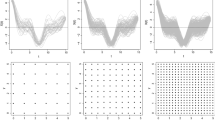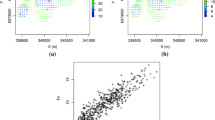Abstract
This paper proposes a spatial functional formulation of the normal mixed effect model for the statistical classification of spatially dependent Gaussian curves, in both parametric and state space model frameworks. Fixed effect parameters are represented in terms of a functional multiple regression model whose regression operators can change in space. Local spatial homogeneity of these operators is measured in terms of their Hilbert–Schmidt distances, leading to the classification of fixed effect curves in different groups. Assuming that the Gaussian random effect curves obey a spatial autoregressive dynamics of order one [SARH(1) dynamics], a second functional classification criterion is proposed in order to detect local spatially homogeneous patterns in the mean quadratic functional variation of Gaussian random effect curve increments. Finally, the two criteria are combined to detect local spatially homogeneous patterns in the regression operators and in the functional mean quadratic variation, under a state space approach. A real data example in the financial context is analyzed as an illustration.





Similar content being viewed by others
References
Abraham C, Cornillon PA, Matzner-Løber E, Molinari N (2003) Unsupervised curve clustering using B-splines. Scand J Stat 30:581–595
Aach J, Church GM (2001) Alignment gene expression time series with time warping algorithms. Bioinformatics 17:495–508
Aguilera AM, Escabias M, Preda C, Saporta G (2010) Using basis expansion for estimating functional PLS regression. Applications with chemometric data. Chemom Intel Lab Syst 104:289–305
Aguilera-Morillo MC, Aguilera AM, Escabias M, Valderrama MJ (2013) Penalized spline approaches for functional logit regression. TEST 22:251–277
Alonso AM, Casado D, Romo J (2012) Supervised classification for functional data: a weighted distance approach. Comput Stat Data Anal 56:2334–2346
Angelini C, De Canditiis D, Leblanc F (2003) Wavelet regression estimation in nonparametric mixed effect models. J Multivar Anal 85:267–291
Baíllo A, Cuevas A (2008) Supervised classification for functional data: a theoretical remark and some numerical comparisons. In: Dabo-Niang S, Ferraty F (eds) Functional and operatorial statistics. Physica-Verlag, Heidelberg, pp 43–46
Baladandayuthapani V, Mallick B, Hong M, Lupton J, Turner N, Caroll R (2008) Bayesian hierarchical spatially correlated functional data analysis with application to colon carcinoginesis. Biometrics 64: 64–73
Basse M, Diop A, Dabo-Niang S (2008) Mean square properties of a class of kernel density estimates for spatial functional random variables. Annales De L’I.S.U.P. Publications de l’Institut de Statistique de l’Université de Paris
Berlinet A, Biau G, Rouviére L (2008) Functional supervised classification with wavelets. Ann lISUP 52:61–80
Biau G, Bunea F, Wegkamp MH (2003) Functional classification in Hilbert spaces. IEEE Trans Inf Theor 1:1–8
Booth L, Aivazian V, Demirguç-Kunt L, Maksimovic V (2001) Capital structures in developing countries. J Fin 56:87–130
Cuesta-Albertos JA, Fraiman R (2007) Impartial trimmed k-means for functional data. Comput Stat Data Anal 51:4864–4877
Chiou J-M, Li P-L (2007) Functional clustering and identifying substructures of longitudinal data. J R Stat Soc Ser B 69:679–699
Chiou J-M, Li P-L (2008a) Correlation-based functional clustering via subspace projection. J Am Stat Assoc 103:1684–1692
Chiou J-M, Li P-L (2008b) Functional clustering of longitudinal data. In: Dabo-Niang S, Ferraty F (eds) Functional and operatorial statistics. Physica-Verlag, Heidelberg, pp 103–107
Daubechies I (1992) Ten lectures on wavelets. SIAM, Philadelphia
Dautray R, Lions JL (1985) Mathematical analysis and numerical. Methods for science and technology. Spectral theory and applications, vol 3. Springer, New York
Delaigle A, Hall P (2012a) Achieving near perfect classification for functional data. J R Stat Soc Ser B 74:267–286
Delaigle A, Hall P (2012b) Methodology and theory for partial least squares applied to functional data. Ann Stat 40:322–352
Delaigle A, Hall P, Bathia N (2012) Componentwise classification and clustering of functional data. Biometrika 99:299–313
Degryse H, De Goeij P, Kappert K (2012) The impact of firm and industry characteristics on small firms’ capital structure. Small Bus Econ 38:431–447
Delicado P, Giraldo R, Comas C, Mateu J (2010) Statistics for spatial functional data: some recent contributions. Environmetrics 21:224–239
Donoho DL (1993) Unconditional bases are optimal bases for data compression and for statistical estimation. J Appl Comput Harmon Anal 1:100–115
Escabias M, Aguilera AM, Valderrama MJ (2004) Principal component estimation of functional logistic regression: discussion of two different approaches. J Nonparametr Stat 16:365–384
Escabias M, Aguilera AM, Valderrama MJ (2007) Functional PLS logit regression model. Computat Stat Data Anal 51:4891–4902
Ferraty F, Vieu P (2003) Curves discrimination: a nonparametric functional approach. Comput Stat Data Anal 44:161–173
Ferraty F, Vieu P (2006) Nonparametric functional data analysis. Springer, New York
Ferraty F, Vieu P (2009) Additive prediction and boosting for functional data. Comput Stat Data Anal 53:1400–1413
Friedman NA (1970) Introduction to ergodic theory. Van Nostrand Reinhold mathematical studies, No 29. Van Nostrand Reinhold Co., New York
Fujikoshi Y, Satoh K (1997) Modified AIC and Cp in multivariate linear regression. Biometrika 84:707–716
Giacofci M, Lambert-Lacroix S, Marot G, Picard F (2013) Wavelet-based clustering for mixed-effects functional models in high dimensions. Biometrics 69:31–40
Giraldo R, Delicado P, Comas C, Mateu J (2010) Hierarchical clustering of spatially correlated functional data. Statistica Neerlandica. doi:10.1111/j.1467-9574.2012.00522.x
Giraldo R, Delicado P, Mateu J (2010b) Continuous time-varying kriging for spatial prediction of functional data: an environmental application. J Agric Biol Environ Stat 15:66–82
Guillas S, Lai MJ (2010) Bivariate splines for spatial functional regression models. J R Stat Soc Ser B 22:477–497
Hall P, Poskitt D, Presnell B (2001) A functional data-analytic approach to signal discrimination. Technometrics 43:1–9
Harten A (1993) Discrete multiresolution analysis and generalized wavelets. J Appl Numer Math 12: 153–193
James GM, Hastie TJ (2001) Functional linear discriminant analysis for irregular sampled curves. J R Stat Soc Ser B 63:533–550
James GM, Sugar CA (2003) Clustering for sparsely sampled functional data. J Am Stat Soc 98:397–408
Kumar BVR, Mehra M (2005) Wavelet based preconditioners for sparse linear systems. Appl Math Comput 171:203–224
Leng X, Müller HG (2006) Time ordering of gene coexpression. Biostatistics 7:569–584
Li PL, Chiou JM (2011) Identifying cluster number for subspace projected functional data clustering original. Comput Stat Data Anal 55:2090–2103
Liu XL, Müller HG (2003) Modes and clustering for time-warped gene expression profile data. Bioinformatics 19:1937–1944
Li B, Yu Q (2008) Classification of functional data: a segmentation approach. Comput Stat Data Anal 52:4790–4800
López-Pintado S, Romo J (2006) Depth-based classification for functional data. In: Liu R, Serfling R, Souvaine DL (eds) Data depth: robust multivariate analysis, computational geometry and applications. DIMACS series, vol 72, pp 103–121
Monestiez P, Nerini D (2008) A cokriging method for spatial functional data with applications in oceanology. Functional and operational statistics. Contrib Stat 36:237–242
Müller HG, Stadtmüller U (2005) Generalized functional linear models. Ann Stat 33:774–805
Nerini D, Monestiez P, Manté C (2010) Cokriging for spatial functional data. J Multivar Anal 101:409–418
Nerini D, Ghattas B (2007) Classifying densities using functional regression trees: applications in oceanology. Comput Stat Data Anal 51:4984–4993
Preda C, Saporta G (2005a) Clusterwise PLS regression on a stochastic process. Comput Stat Data Anal 49:991–2008
Preda C, Saporta G (2005b) PLS regression on a stochastic process. Comput Stat Data Anal 48:149–158
Ramsay JO, Silverman BW (2005) Functional data analysis, 2nd edn. Springer, New York
Rincón M, Ruiz-Medina MD (2012) Local wavelet-vaguelette-based functional classification of gene expression data. Biometr J 54:75–93
Romano E, Balzanella A, Verde R (2010) Clustering spatio-functional data: a model-based approach. Studies in classification, data analysis, and knowledge organization. Springer, New York
Romano E, Verde R (2011) Clustering geostatistical functional data. In: Di Ciaccio A, Coli M, Angulo JM (eds) Advanced statistical methods for the analysis of large data-sets. Studies in theoretical and applied statistics. Springer, Berlin, pp 23–31
Romano E, Balzanella A, Verde R (2013) A regionalization method for spatial functional data based on variogram models: an application on environmental data. In: Advances in theoretical and applied statistics, Springer, Berlin, Heidelberg
Rossi F, Villa N (2006) Support vector machine for functional data classification. Neurocomputing 69:730–742
Ruiz-Medina MD (2011) Spatial autoregressive and moving average Hilbertian processes. J Multivar Anal 102:292–305
Ruiz-Medina MD (2012a) Spatial functional prediction from spatial autoregressive Hilbertian processes. Environmetrics 23:119–128
Ruiz-Medina MD, Anh VV, Espejo RM, Frías MP (2013) Heterogeneous spatial dynamical regression in a Hilbert-valued context. Stoch Anal Appl 31:509–527
Ruiz-Medina MD, Espejo RM (2012b) Spatial autoregressive functional plug-in prediction of ocean surface temperature. Stoch Environ Res Risk A 26:335–344
Schölkopf B, Smola A (2002) Learning with kernels. MIT Press, Cambridge
Spitzner D, Marron JS, Essick GK (2002) Mixed-model functional ANOVA for studying human tactile perception. Behav Brain Res 135:43–49
Stein ML (1999) Interpolation of spatial data: some theory for kriging. Springer, New York
Stein ML (2009) Spatial interpolation of high-frequency monitoring data. Ann Appl Stat 3:272–291
Tarpey T, Kinateder KKJ (2003) Clustering functional data. J Classif 20:93–114
Yang JY, Peng ZL, Yu Z, Zhang RJ, Anh V, Wang D (2009a) Prediction of protein structural classes by recurrence quantification analysis based on chaos game representation. J Theor Biol 257:618–626
Yang JY, Yu Z, Anh V (2009b) Clustering structures of large proteins using multifractal analyses based on a 6-letter model and hydrophobicity scale of amino acids. Chaos Solitons Fractals 40:607–620
Zhang Z, Müller HG (2011) Functional density synchronization. Comput Stat Data Anal 55:2234–2249
Acknowledgments
This work has been supported in part by projects MTM2012-32674 (co-funded with FEDER) of the DGI, MEC, and P09-FQM-5052 of the Andalousian CICE, Spain. We would like to thank to Professor M.J. Palacín-Sánchez from the Department of Financial Economics and Operations Management of Sevilla University, Spain for her helpful comments and assessment, as well as for facilitating the financial data set.
Author information
Authors and Affiliations
Corresponding author
Rights and permissions
About this article
Cite this article
Ruiz-Medina, M.D., Espejo, R.M. & Romano, E. Spatial functional normal mixed effect approach for curve classification. Adv Data Anal Classif 8, 257–285 (2014). https://doi.org/10.1007/s11634-014-0174-6
Received:
Revised:
Accepted:
Published:
Issue Date:
DOI: https://doi.org/10.1007/s11634-014-0174-6
Keywords
- Empirical functional variogram
- Firm financial structure
- Functional multiple regression
- Spatial functional mixed effect models
- Spatial Hilbert-valued Gaussian processes




